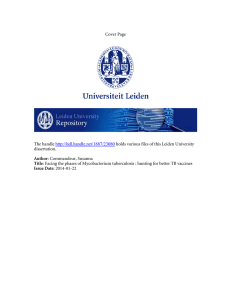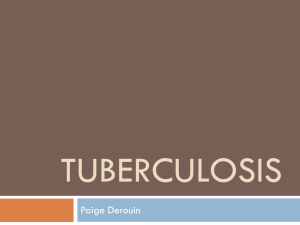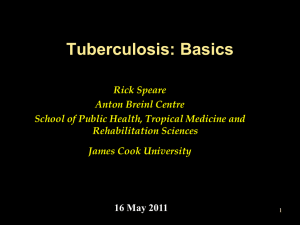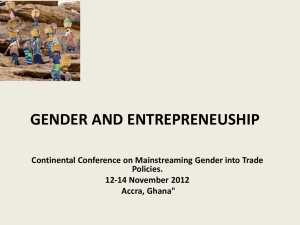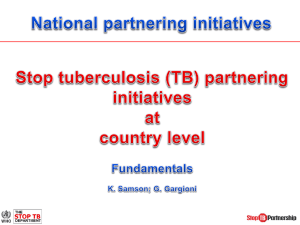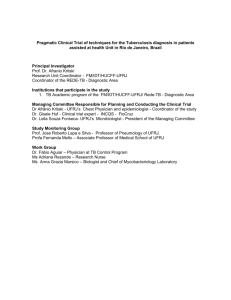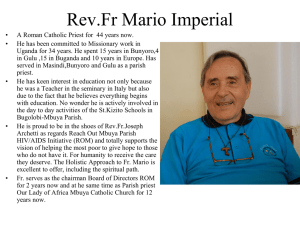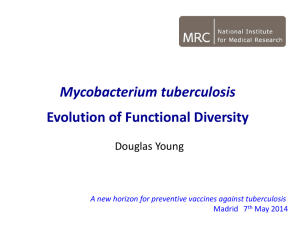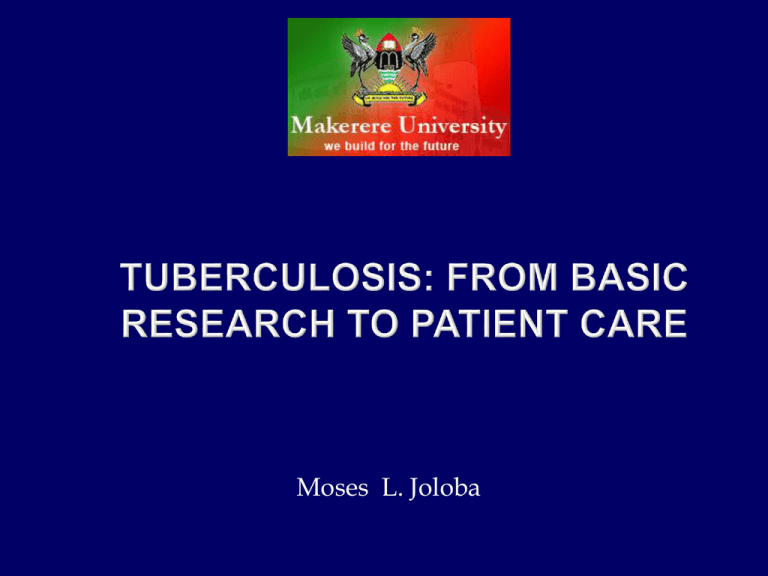
Moses L. Joloba
Mycobacterium tuberculosis (MTB), is the causative agent of
tuberculosis (TB)
1.7 billion people infected with MTB worldwide
The majority have latent infection
Each year, 9 million develop disease
2 million die of TB annually
TB is the single largest cause of death from a curable
and preventable infectious disease
Millions of deaths in 2002
3.0
2.0
1.0
0.0
HIV/AIDS
Tuberculosis
Malaria
Measles
Uganda is one of the 22 countries most affected by TB in the
world.
In Uganda we detect 40,000 cases per year
This represents 50% of the cases to be detected.
About 70% of those detected are cured
WHO recommends 70% detection rate and 85% cure rates
Presented under the following areas:
A – Diagnosis
B – Identification
C – Drug susceptibility testing (DST)
D – Epidemiology
PREVIOUS (< 2006)
Light microscopy
CURRENT
Solid culture (LJ and
Middlebrook)
Semi automated Liquid
culture Bactec 460 in
JCRC
Florescent Microscope
Automated Liquid culture system
(MGIT)
Portable Liquid culture system
(Manual MGIT)
Direct phenotypic DST methods
HAIN Test for MDR detection
HAIN Test for speciation
PCR for Identification
Capillia for Identification
RFLP, Spoligotyping, RD analysis and
MIRU for epidemiology
TB diagnostic
testing in
endemic
countries
Fundamental
diagnostic: 1882
Fundamental
diagnostic: 2007
TB diagnostic
testing in
endemic
countries
Fundamental
diagnostic: 1882
Fundamental
diagnostic: 2008
Binocular microscopes – covers 80% of the country in
Uganda
Florescent microscopes (LEDs) for very busy centers
More sensitive than light X-scopes
Decrease workload – scan fewer fields
LEDs do not need dark rooms and have long life bulbs
Introduction of External Quality Assurance (EQA), covers
90% of the country (Uganda) – ensures quality (2005)
Change in diagnostic policy (2008)
2 smears instead of 3
One positive smear instead of 2 enough to start therapy
NTRL – Wandegeya
FIND – Wandegeya
JCRC - Mengo
MRC- Entebbe
AERAS – Medical School
MSF – Epicentre - Mbarara
Solid – LJ…
Liquid Bactec 460
• Solid – LJ…
• Liquid culture
1. Automated MGIT 960
2.
Manual
MGIT
3. Bactec 9000 series for fluids
BEFORE 2006
Presumptive (accurate for
solids)
Colony morphology
Growth rate
ZN
CURRENT
Presumptive for solid –
phasing out
PCR for IS6110
Capillia – key for liquid system
NAP for Bactec 460
BEFORE 2006
Indirect proportion by LJ and Bactec 460
TAT 3 weeks
TAT 3 month
1. Genotype MTBDR – Detects MDR TB in one day
PCR
2. Drect MGIT – 5d
Hybridization
Detection
3. Nitrate reductase assay – 14d
4. MODS assay – 10d
TOTAL HANDS-ON TIME = 2 MINUTES
The system is the first to fully automate and integrate all the steps required
for PCR-based DNA testing: sample preparation, DNA amplification and
detection. Designed to simplify hands-on preparation, the system provides
PCR test results from a raw sample in about an hour, enabling time-critical
DNA tests at the point of need.
Previously none
Now using PCR RD analysis we can speciate MTB
complex into
M. tuberculosis
M. africanun
M. bovis
M. bovis BCG
M. canneti
M. microti
M. pimpinedi
……
Asiimwe BB, Koivula T, Kallenius G, Huard RC, Ghebremichael S,
Asiimwe J, Joloba ML. Mycobacterium tuberculosis Uganda Genotype
is the predominant cause of TB in Kampala, Uganda. Int J Tuberc Lung
Dis 2008; 12(4): 386 - 389.
Through use of PCR based GenoType Mycobacterium CM from HAIN we can
speciate MOTT into 14 species (2008)
M. avium spp.
•
M. chelonae
• M. Kansasii
M. abscessus
• M. malmoense
M. fortiutum
• M. peregrinum
M. gordonae
• M. marinum/M. ulcerans
M. intracellulare
• M. tuberculosis
complex
M. scrofulaceum
M. interjectum
• M. xenopi.
RFLP
Spoligotyping – PCR Based
MIRU – PCR based
No. of
IS6110
Isolates copies
2
8
5
2
6
3
2
3
3
3
2
2
2
3
2
2
3
3
2
2
3
2
3
3
2
2
2
2
2
3
3
4
6
2
11
14
14
01
17
12
10
12
01
11
15
18
17
13
09
14
15
15
17
16
17
13
16
17
16
15
08
15
15
16
10
14
11
04
Sex
F (M)
HIV
+ (-)
1 (1)
3 (5)
4 (1)
1 (1)
3 (3)
2 (1)
1 (1)
1 (2)
2 (1)
2 (1)
0 (2)
0 (2)
0 (2)
2 (1)
0 (2)
1 (1)
2 (1)
1 (2)
1 (1)
1 (1)
1 (2)
0 (2)
2 (1)
0 (3)
0 (2)
1 (1)
1 (1)
0 (2)
2 (0)
1 (2)
1 (2)
4 (0)
2 (4)
1 (1)
0 (2)
4 (4)
2 (3)
1 (1)
4 (2)
2 (1)
0 (2)
1 (2)
1 (2)
3 (0)
0 (2)
0 (2)
0 (2)
0 (3)
2 (0)
1 (1)
0 (3)
2 (1)
0 (2)
1 (1)
3 (0)
0 (2)
2 (1)
0 (3)
2 (0)
1 (1)
1 (1)
1 (1)
1 (1)
0 (3)
2 (1)
2 (2)
2 (4)
1 (1)
Age, years
<40 (>40)
2 (0)
7 (1)
4 (1)
2 (0)
3 (3)
3 (0)
2 (0)
3 (0)
3 (0)
2 (1)
2 (0)
2 (0)
2 (0)
3 (0)
2 (0)
2 (0)
2 (1)
3 (0)
0 (2)
1 (1)
3 (0)
0 (2)
3 (0)
3 (0)
2 (0)
2 (0)
1 (1)
2 (0)
2 (0)
3 (0)
3 (0)
4 (0)
5 (1)
2 (0)
Benon B.Asiimwe,1,2 Moses L. Joloba2, Solomon Ghebremichael1,3, Tuija Koivula4, David P. Kateete2,
Fred K. Ashaba2, Alexander Pennhag3, Ramona Petersson3, and Gunilla Kallenius*,1,3. DNA Restriction
Fragment Length Polymorphism Analysis of Mycobacterium
tuberculosis Isolates from HIV-Seropositive and HIV-seronegative Patients in Kampala,
Uganda. (Submitted to Clinical Microbiology and Infection)
IS6110-RFLP clustering
Fig. 1. Description of 33 clustered spoligotypes (2 to 49 cases) in the study
Order STa
1
2
3
4
5
6
7
8
9
10
11
12
13
14
15
16
17
18
19
20
21
22
23
24
25
26
27
28
29
30
31
32
33
1
128
135
52
UGA1
590
21
125
UGA2
42
26
UGA3
78
UGA4
UGA5
UGA6
UGA7
UGA8
UGA9
4
142
UGA10
59
UGA11
UGA12
UGA13
UGA14
UGA15
UGA16
UGA17
64
288
UGA18
Nb (%)
04 (1.2)
49 (14.2)
38 (11.0)
26 (7.6)
17 (4.5)
15 (4.4)
12 (3.5)
11 (3.2)
10 (2.9)
09 (2.6)
09 (2.6)
09 (2.6)
09 (2.6)
09 (2.6)
09 (2.6)
09 (2.6)
08 (2.3)
07 (2.0)
07 (2.0)
06 (1.7)
06 (1.7)
06 (1.7)
05 (1.5)
05 (1.5)
04 (1.2)
04 (1.2)
03 (0.9)
03 (0.9)
03 (0.9)
02 (0.6)
02 (0.6)
02 (0.6)
02 (0.6)
Spoligotype Patternc
Labeld
Beijing
T2
T2-Uganda
T2
ND
T2
CAS1_KILI
T2
T2
LAM9
CAS1_DELHI
T2
T1-T2
T2
T2
T2
T2
T2
T2
LAM3/S
CAS1
T2
LAM11-ZWE
T2
ND
ND
ND
ND
ND
ND
LAM6
CAS2
ND
aAs
identified in SpolDB4.0; ST, Shared Type; Nb, Number of isolates (as a percentage of total M. tuberculosis strains in the
study); cFilled boxes represent positive hybridization while empty boxes represent absence of spacers; dLabel defining the
lineage/sub lineage; ND, Not yet determined in SpolDB4.0.
Asiimwe BB, Ghebremichael S, Kallenius G, Koivula T, Joloba ML. Mycobacterium tuberculosis spoligotypes and drug susceptibility pattern of isolates from tuberculosis
patients in peri-urban Kampala, Uganda. BMC Infect Dis. 2008 Jul 28;8(1):101. [Epub ahead of print] PMID: 18662405 [PubMed - as supplied by publisher]
Need to strengthen systems to utilize existing and new
technology
Develop good tools to monitor lab performance
Train TB teams at point of care
Searching for Point
of care test


